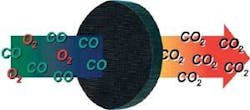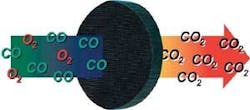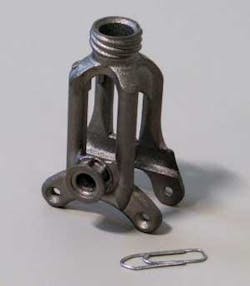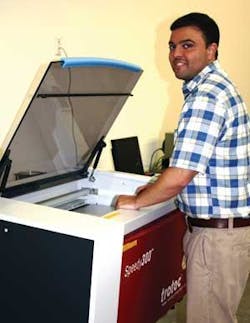Catalyst improves laser performance
Hampton, VA—STC Catalysts Inc. (SCi) is the only commercial manufacturer and distributor of a low-temperature oxidation catalyst for use in industrial carbon dioxide lasers and other applications. This catalyst oxidizes carbon monoxide to carbon dioxide at or below room temperature. The conversion rate increases as the exothermic reaction causes the temperature to increase, but heating the catalyst is not required. Installing the catalyst in any carbon dioxide laser improves laser output power and performance, and significantly reduces the need for adding costly makeup gas. An additional advantage of using this catalyst is that there is no dusting of catalyst material to contaminate the laser optics.
For industrial lasers used in welding, drilling, and cutting, the catalyst improves performance, and, in some slow-flow lasers, has reduced operating gas costs as much as 75%. Similar results are seen in high pressure and high pulse rate lasers as well.
Operating lifetimes before reactivation or replacement vary with the environment and the degree to which the catalyst surface is contaminated by pump oil. But 1500 to 2500 operating hours are typical, and 4000 hours was reached in one case where a chilled water cooler was included in the vacuum system. Also, a one-step reactivation process has been developed which allows reactivation of used catalysts at the SCi manufacturing facility for customers.
The catalyst has also been successfully tested in several commercial TEA lasers and in high pressure, high repetition rate giga-watt and terra-watt research lasers. In one such TEA system, sustained operation of more than 150 million pulses was achieved before a non-catalyst related failure of the laser occurred.
SCi’s catalyst was developed at the NASA Langley Research Center in Hampton, Virginia, with the support of SCi co-inventor chemists, as part of the NASA Laser Atmospheric Wind Sounder (LAWS) Program for space-based global tropospheric wind measurements. The catalyst was to sustain on-orbit operation of the laser for a minimum of one-billion pulses over a five-year period, without any addition of makeup gas or heating of the catalyst.
For additional information about this catalyst contact SCi at www.stc-catalysts.com
Laser sintering for titanium
Cincinnati, OH—Morris Technologies Inc. (MTI; www.morristech.com) is a rapid prototyping company that turns designs into production-quality metal parts in hours through its wide range of capabilities, including direct metal laser sintering (DMLS). DMLS offers advantages because it eliminates tooling, makes parts with complex internal and external geometries in a single operation, and produces multiple parts at the same time.
In May the company purchased an EOSINT M 270 system to laser sinter titanium. The machine will be installed in Xtended Mode, including new features that improve the performance for producing titanium parts, enabling these to be built much faster and in enhanced quality compared to the first generation titanium process, which was launched in 2007.
EOS GmbH Electro Optical Systems reports that this is the first North American purchase of an EOSINT M 270 in Xtended Mode, and it is the ninth DMLS system that MTI has acquired from EOS—the most of any lab or manufacturer in the world. MTI will use the new system to offer rapid prototyping and manufacturing in titanium to its customers in the aerospace and medical industries.
“We were the first U.S. firm to install DMLS equipment,” says Greg Morris, CEO/COO of MTI, “and yearly demand for laser sintering services has increased. We expect interest in titanium parts to follow the same strong demand curve.”
The EOSINT M 270 system uses laser sintering to additively manufacture parts layer by layer. A range of metal materials is available, including steels, cobalt- and nickel-based superalloys and titanium alloys. EOS Titanium Ti64 is a pre-alloyed Ti6AL4V alloy with excellent mechanical properties and corrosion resistance, low specific weight, and biocompatibility. Parts built from this alloy can be machined, spark-eroded, welded, micro shot peened, polished, and coated as needed. Typical uses include dental, orthopedic, and airframe applications.
For more information, visit www.eos.info.
Making a mark with the Marines
Portsmouth, RI—A2B Tracking Solutions Inc. (www.uidsolutions.com), a leading supplier of total solutions for barcode tracking, was awarded a one-year contract from the Marine Corps System Command to supply IUID marking kits to Marine Corps installations worldwide (see www.industrial-lasers.com). ILS spoke with Marc Corriveau, sales manager for A2B, who amplified on the initial press release.
The Marine Corps had need for an integrated marking kit that would enable installation users to take a marking capability to a marking need, for example in a large warehouse.
This marking kit could either employ a laser marking capability or a thermal resin marker, the choice being the material to be marked. The latter is used for marking polyester labels while the former is used for other label materials.
The integrated laser marking kit is self contained with the CO2 laser mounted on the kit and supported by a kit-mounted exhaust system and other peripherals. All that is need is access to a facility power source, in the laser’s case a simple plant electrical outlet.
A2B has been working on UID compliance for several years and its software (UID Comply!) is considered the standard for this application. The Department of Defense has mandated that all branches comply with this standard, MIL STD 130, so A2B software has become the industry leader.
In the Marine Corps application A2B provides marking and operational software and system integration, assuming full responsibility for the system and the subcontractor supplied hardware, such as the laser and fume extraction equipment. A CO2 laser from Trotec was A2B’s choice due to its flexibility, reliability, throughput capability, and the ability to mark the widest selection of materials.
For additional information on IUID marking and the Marine Corps application, contact Marc Corriveau ([email protected]).
Bicycle brake manufactured using direct metal laser sintering.



